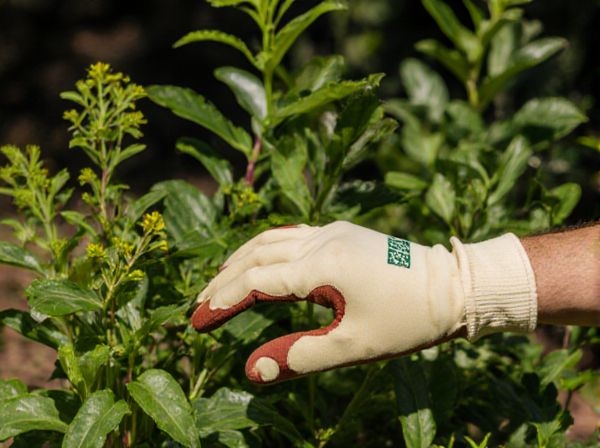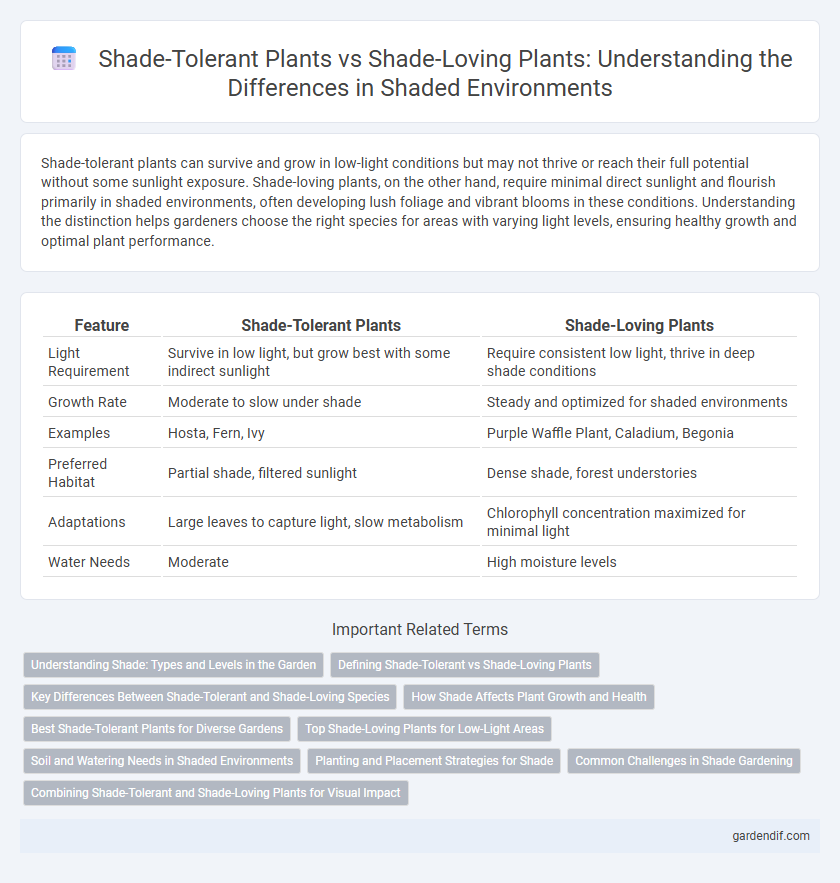
shade-tolerant plants vs shade-loving plants Illustration
Shade-tolerant plants can survive and grow in low-light conditions but may not thrive or reach their full potential without some sunlight exposure. Shade-loving plants, on the other hand, require minimal direct sunlight and flourish primarily in shaded environments, often developing lush foliage and vibrant blooms in these conditions. Understanding the distinction helps gardeners choose the right species for areas with varying light levels, ensuring healthy growth and optimal plant performance.
Table of Comparison
| Feature | Shade-Tolerant Plants | Shade-Loving Plants |
|---|---|---|
| Light Requirement | Survive in low light, but grow best with some indirect sunlight | Require consistent low light, thrive in deep shade conditions |
| Growth Rate | Moderate to slow under shade | Steady and optimized for shaded environments |
| Examples | Hosta, Fern, Ivy | Purple Waffle Plant, Caladium, Begonia |
| Preferred Habitat | Partial shade, filtered sunlight | Dense shade, forest understories |
| Adaptations | Large leaves to capture light, slow metabolism | Chlorophyll concentration maximized for minimal light |
| Water Needs | Moderate | High moisture levels |
Understanding Shade: Types and Levels in the Garden
Shade-tolerant plants can survive and grow in low light conditions but often require some indirect sunlight, while shade-loving plants thrive best in deep shade environments with minimal light. Understanding the types of shade--such as dappled, partial, or dense shade--and their intensity levels is crucial for selecting the right plants that suit specific garden areas. This knowledge ensures optimal growth, health, and aesthetics by matching plant species to the available light conditions in the garden.
Defining Shade-Tolerant vs Shade-Loving Plants
Shade-tolerant plants have adapted to survive and grow in low-light conditions but can also thrive with some direct sunlight, whereas shade-loving plants require consistent, low-light environments to flourish. Shade-tolerant species such as ferns and hostas exhibit flexibility in light exposure and generally maintain healthy photosynthesis under partial shade. In contrast, shade-loving plants like impatiens and begonias depend on filtered or indirect light, often showing stress or leaf burn when exposed to intense sunlight.
Key Differences Between Shade-Tolerant and Shade-Loving Species
Shade-tolerant plants survive and grow adequately in low-light environments but often require some indirect light to thrive, whereas shade-loving plants, also known as shade-preferring species, flourish exclusively in deep or dense shade with minimal sunlight exposure. Key differences include physiological adaptations; shade-tolerant species typically have larger, thinner leaves to maximize photosynthesis in low light, while shade-loving plants possess specialized chlorophyll compositions allowing efficient energy absorption under diffuse light. Growth rate and habitat preference also vary, with shade-tolerant plants exhibiting moderate growth in partial shade environments compared to shade-loving plants that dominate understory ecosystems with dense canopy coverage.
How Shade Affects Plant Growth and Health
Shade-tolerant plants adapt to low light by maximizing chlorophyll efficiency and adjusting leaf structure to capture limited sunlight, ensuring steady photosynthesis and growth. Shade-loving plants thrive in dim environments with reduced risk of leaf scorch and moisture loss, promoting enhanced vitality and resilience under canopy cover. Both plant types exhibit physiological modifications that optimize growth and health by balancing light absorption with energy conservation in shaded habitats.
Best Shade-Tolerant Plants for Diverse Gardens
Shade-tolerant plants, such as hostas and ferns, thrive in low-light conditions by adapting to limited sunlight, making them ideal for garden areas with minimal direct sun exposure. Shade-loving plants, like astilbe and bleeding hearts, not only survive but flourish in shaded environments, offering vibrant blooms and varied foliage. Choosing the best shade-tolerant plants for diverse gardens enhances biodiversity, supports ecological balance, and ensures year-round visual interest in shaded landscapes.
Top Shade-Loving Plants for Low-Light Areas
Shade-loving plants such as ferns, hostas, and calatheas thrive in low-light environments with minimal direct sunlight, making them ideal for shaded gardens and indoor spaces. These plants exhibit adaptations like larger leaves and slower growth rates to maximize photosynthesis under dim conditions. Selecting top shade-loving plants ensures lush greenery and vibrant foliage in areas where shade-tolerant species may struggle to maintain optimal health.
Soil and Watering Needs in Shaded Environments
Shade-tolerant plants typically require well-draining soil with moderate moisture retention to thrive in low-light environments, while shade-loving plants prefer consistently moist, nutrient-rich soil to support their growth under canopy cover. Both types benefit from regular watering schedules adjusted to prevent waterlogging, which can lead to root rot in shaded conditions with less evaporation. Understanding the specific soil composition and hydration needs of these plants ensures optimal health and vibrant foliage in shaded garden settings.
Planting and Placement Strategies for Shade
Shade-tolerant plants thrive in low-light conditions by adapting their photosynthetic processes, making them ideal for planting under dense canopies or north-facing garden areas where sunlight is minimal. Shade-loving plants, on the other hand, require indirect or filtered light and benefit from placement in locations with dappled sun or morning shade to optimize growth and flowering. Effective planting strategies include assessing light intensity, soil moisture, and air circulation to select species such as hostas, ferns, or astilbes, ensuring healthy development and vibrant foliage in shaded garden zones.
Common Challenges in Shade Gardening
Shade-tolerant plants often struggle with limited sunlight, leading to slower growth and less vibrant foliage compared to sun-loving varieties. Shade-loving plants adapt to lower light levels but frequently face issues like excessive moisture retention, increasing susceptibility to fungal diseases. Both types require careful selection and management to optimize soil quality, drainage, and air circulation for successful shade gardening.
Combining Shade-Tolerant and Shade-Loving Plants for Visual Impact
Combining shade-tolerant plants such as hostas and ferns with shade-loving varieties like impatiens and begonias creates a diverse garden layered with texture and color. Shade-tolerant plants adapt to low-light conditions by utilizing limited sunlight efficiently, while shade-loving plants thrive in filtered or indirect light, offering vibrant blooms. Strategically interspersing these species enhances visual depth and seasonal interest, maximizing garden aesthetics in shaded areas.
shade-tolerant plants vs shade-loving plants Infographic

 gardendif.com
gardendif.com